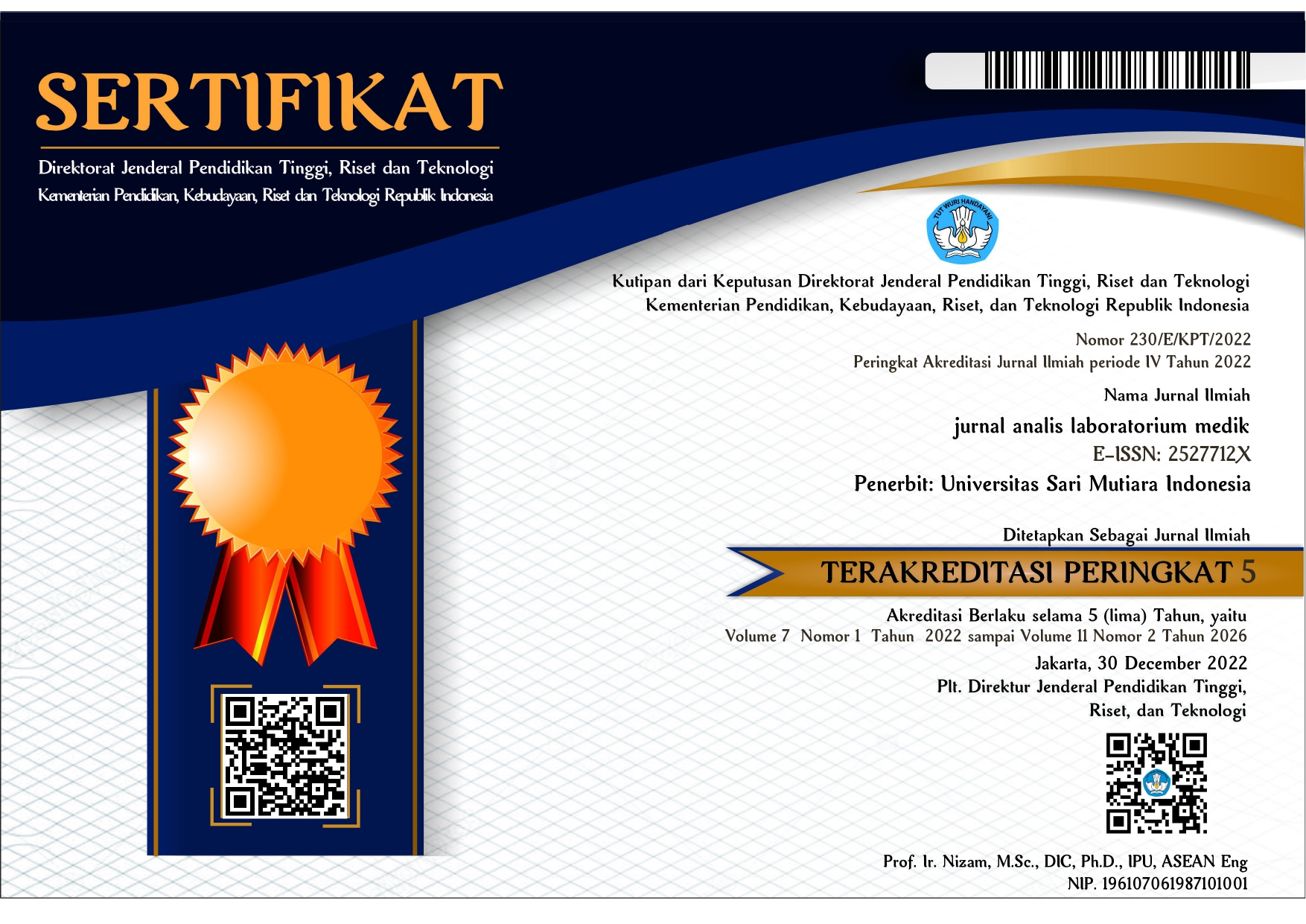ANALYSIS OF WIDAL SLIDE TEST ON TIFOID FEVER PATIENTS IN SUNDARI MEDAN GENERAL HOSPITAL
DOI:
https://doi.org/10.51544/jalm.v7i1.2903Keywords:
Typhoid Fever, Salmonella sp, idal testAbstract
Typhoid fever is an acute systemic disease caused by Salmonella typhi and Salmonella paratyphi A, B and C are characterized by prolonged fever, bacteremia without changes in the endothelial system. Salmonella is a genus of gram-negative enterobacteria bacteria in the form of rods, flagellated, without spores, capsules, and anaerobes that cause typhoid and paratyphoid. Salmonella is the leading cause of foodborne illness. In general, Salmonella causes diseases of the digestive organs. Salmonella antigen structure consists of flagellar antigen (H antigen), somatic antigen (O antigen). Widal test is a serological test procedure to detect Salmonella typhi bacteria infection that causes typhoid fever. This test will show the Salmonella antibody reaction to O- somatic, H-flagellar and Vi (bacterial hoops) antigens in the blood. Culture is the gold standard in examining typhoid fever cases to date because in culture we can determine the morphology of Salmonella. This type of research is a descriptive study that aims to analyze the results of the Widal Slide Test with the agglutination method in the Sundari General Hospital Laboratory, Medan. Of the 15 samples analyzed, the results of the Widal Slide Test were obtained for 33% of typhoid fever patients with agglutination and 67% of those without agglutination. The results were Salmonella typhi O = 4 samples, Salmonella typhi H = 1 sample, Salmonella paratyphi AO = 1 sample, Salmonella paratyphi BO = 2 samples, and Salmonella paratyphi CO = 3 samples. This type of research is a descriptive study that aims to analyze the results of the Widal Slide Test with the agglutination method in the Sundari General Hospital Laboratory, Medan. Of the 15 samples analyzed, the results of the Widal Slide Test were obtained for 33% of typhoid fever patients with agglutination and 67% of those without agglutination. The results were Salmonella typhi O = 4 samples, Salmonella typhi H = 1 sample, Salmonella paratyphi AO = 1 sample, Salmonella paratyphi BO = 2 samples, and Salmonella paratyphi CO = 3 samples. This type of research is a descriptive study that aims to analyze the results of the Widal Slide Test with the agglutination method in the Sundari General Hospital Laboratory, Medan. Of the 15 samples analyzed, the results of the Widal Slide Test were obtained for 33% of typhoid fever patients with agglutination and 67% of those without agglutination. The results were Salmonella typhi O = 4 samples, Salmonella typhi H = 1 sample, Salmonella paratyphi AO = 1 sample, Salmonella paratyphi BO = 2 samples, and Salmonella paratyphi CO = 3 samples.
Downloads
References
Anonymous, 2013. Qualitative and Quantitative Methods of Widal Examination, Serology Practicum Guide, Manado Health Analyst Department.
Darmawati, S, 2009. Genetic Diversity of Salmonella typhi. FIKKESUNIMUS
Health Journal, Semarang.
Ghadia Putri, et al. 2016. Comparison of Methods for Diagnosis of Typhoid Fever, Unpad Ministry of Health of the Republic of Indonesia, 2011. Bulletin of the Window of Health Data and Information, Jakarta: Ministry of Health of the Republic of Indonesia
Linda Ayu L, 2016. Overview of the Widal Examination Results Slide Method Using Serum and Plasma EDTA for Typhoid Fever Patients, Kendari Health Polytechnic.
Siti Boedana Krisno 2001, Immunology Diagnostics and Laboratory Procedures, FKUI Jakarta.
Surya H, Stiawan B, Sharti H, Sudoyo A, and Loho T. 2007. Tubex TF test compared to Wildal test in diagnostics of typhoid fever, Jakarta : Faculty of Medicine, University of Indonesia
Yuli Wulan Sari, 2013. Factors of Environmental Sanitation Relation to Typhoid Fever Incidence. University of Muhammadiyah Surakarta
Downloads
Published
How to Cite
Issue
Section
License
Syarat yang harus dipenuhi oleh Penulis sebagai berikut:
Â
- Penulis menyimpan hak cipta dan memberikan jurnal hak penerbitan pertama naskah secara simultan dengan lisensi di bawah Creative Commons Attribution License yang mengizinkan orang lain untuk berbagi pekerjaan dengan sebuah pernyataan kepenulisan pekerjaan dan penerbitan awal di jurnal ini.
- Penulis bisa memasukkan ke dalam penyusunan kontraktual tambahan terpisah untuk distribusi non ekslusif versi kaya terbitan jurnal (contoh: mempostingnya ke repositori institusional atau menerbitkannya dalam sebuah buku), dengan pengakuan penerbitan awalnya di jurnal ini.
- Penulis diizinkan dan didorong untuk mem-posting karya mereka online (contoh: di repositori institusional atau di website mereka) sebelum dan selama proses penyerahan, karena dapat mengarahkan ke pertukaran produktif, seperti halnya sitiran yang lebih awal dan lebih hebat dari karya yang diterbitkan. (Lihat Efek Akses Terbuka).





 This work is licensed under a
This work is licensed under a 




